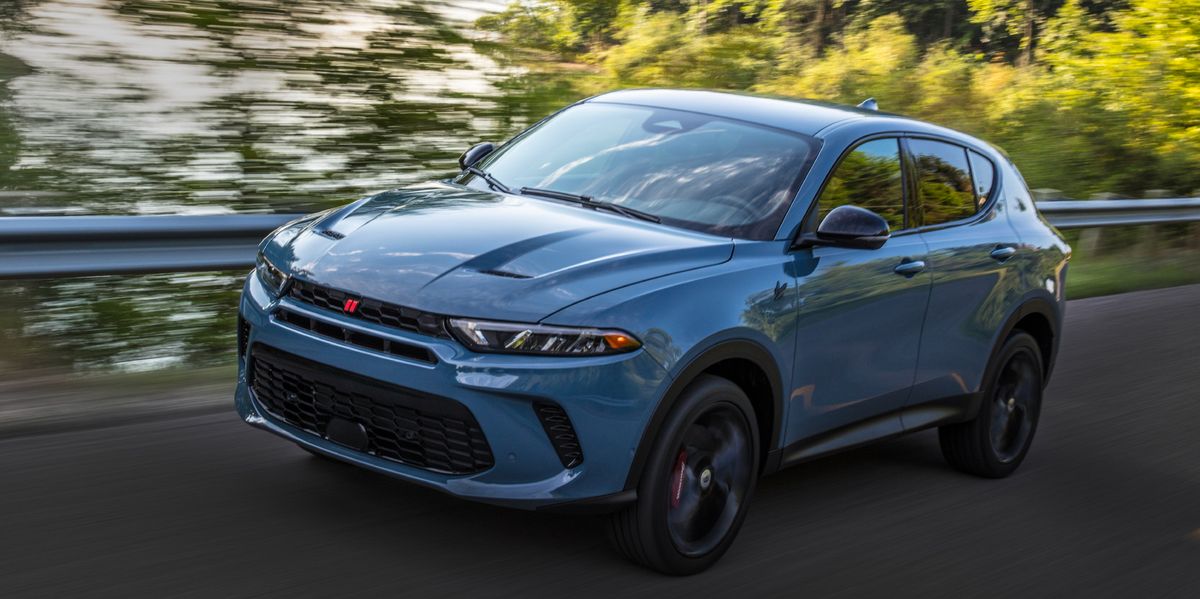2023 Dodge Hornet Is Dawn of Brand's 'Electrified Performance' Era

The 2023 Dodge Hornet is a new subcompact SUV with a performance-focused, plug-in-hybrid model.There’s also a gas-only Hornet that starts around $30,000, and it’s offered with similar features and options.With Dodge about to enter a new “electrifed performance” era, the Hornet leads the way when the PHEV hits dealers next spring starting around $40,000.
A new era is dawning at Dodge. For at least the past decade, the brand’s survival has largely relied on retro-themed, V-8–powered hits like the Charger and Challenger. Hell, it even offered a 710-hp Durango with an estimated 13 mpg combined. While the Hellcat SUV is back for 2023, along with myriad special editions of the muscle-car duo, Dodge has declared last call. The decision comes as the brand takes a hard left towards an electrified future, one that begins with the new 2023 Dodge Hornet.
Dodge’s New Direction
The Hornet is a subcompact SUV that shares a platform and other parts with the Alfa Romeo Tonale. It measures 178 inches long, up to 63.8 inches tall, and rides on a 103.8-inch wheelbase. It’s also the first entirely new model that Dodge has introduced since the ill-fated Dart compact sedan, which only lasted from 2012 to 2016. The Hornet represents the company’s first plug-in-hybrid model, too, but rather than focus on fuel efficiency, Dodge is boasting about the new hybrid’s performance. CEO Tim Kuniskis even billed the Hornet as the “first electrified performance vehicle from Dodge.”
Before you worry about all of Dodge’s future performance models being hybrid crossovers, don’t forget that the company plans to unveil a concept version of its electric muscle car this week, too. So it’s not leaving its roots entirely. Plus, the 2023 Hornet actually has some legitimate performance attributes, and they’re not limited to the plug-in-hybrid model. There’s also a base nonhybrid model with a turbocharged gas engine, and it’s offered with many of the same features and options as the PHEV.
The standard shared bits from the Alfa include a fully independent suspension, Koni dampers, and torque-vectoring all-wheel drive. The PHEV comes standard with Brembo four-piston, fixed front calipers, which are also available on the base model. Likewise, every Hornet is available with the Track Pack, which includes 20-inch wheels, upgraded dampers, and unique styling bits.
Powertrain Comparisons
The Hornet GT is the entry point. It features a turbocharged 2.0-liter inline-four that makes 268 horsepower and 295 pound-feet of torque. The engine pairs with a nine-speed automatic transmission. Dodge estimates the GT will go from zero to 60 mph in 6.5 seconds on its way to a top speed of 140 mph.
The Hornet R/T is the plug-in hybrid. It combines a turbocharged 1.3-liter inline-four, six-speed automatic, and a 121-hp electric motor mounted on the rear axle. The total system output is 288 horsepower and 383 pound-feet of torque. It also features a “PowerStop” function that delivers an extra 25 horsepower and instant torque for 15-second bursts. While its top speed is limited to a lower 128 mph, it should be quicker than its nonhybrid counterpart. Dodge estimates the PHEV will go from zero to 60 mph in 6.1 seconds. For comparison, that’s slightly behind a 250-hp Mazda CX-30 we tested that hit 60 in 5.8 ticks.
The Hornet R/T’s lithium-ion battery pack has a 12.0-kWh useable capacity, and with its 7.2-kW onboard charger, Dodge estimates a Level 2 connection can refill the battery in about 2.5 hours. While we’re told it’ll have an electric-only driving range of around 30 miles, EPA ratings for either powertrain haven’t been released yet.
Designed by Dodge
From the outside, the Hornet’s connection to the Tonale is obvious. Both are also built in Italy. The Dodge’s most notable design difference is the prominent heat extractors on its hood, which are reminiscent of those seen on more muscular models. Also seen on other performance-focused Dodges is the mail slot-looking piece that separates the upper and lower grilles. A set of narrow headlights with upside-down boomerangs for accent lights and full-width taillights further distinguish the Hornet’s appearance. Both the GT and R/T are available with a Blacktop package that includes black 18-inch wheels along with gloss-black exterior badges and mirror caps.
Inside, the Hornet’s dashboard prioritizes the driver by canting the controls to the left. There’s a flat-bottom steering wheel with shift paddles and a button to select different drive modes. Every model features a 12.3-inch digital gauge cluster and a 10.3-inch infotainment display with Uconnect5 software. Among the system’s many standard features are wireless Apple CarPlay and Android Auto.
While the standard interior is black cloth with red contrast stitching, opting for the GT Plus or R/T Plus trims add leather upholstery that’s offered in red. These upper trims also add wireless smartphone charging and a fancier sound system in the form of a 465-watt, 14-speaker Harman Kardon unit. All Hornets comes standard with driver-assistance tech such as automated emergency braking, blind-spot monitoring, and lane-keeping assist. Opting for the Tech Pack unlocks adaptive cruise control, parking assist, and more.
Dodge says the 2023 Hornet GT starts at $29,995 before destination, so we expect its actual starting MSRP to be around $31,000. The same goes for the R/T, which is priced at $39,995 before destination. Orders for the GT model open tomorrow, and it will reach dealers this December. Dodge hasn’t said when orders will open for the R/T, but it’ll be sometime before it hits dealerships next spring.
This content is imported from {embed-name}. You may be able to find the same content in another format, or you may be able to find more information, at their web site.



